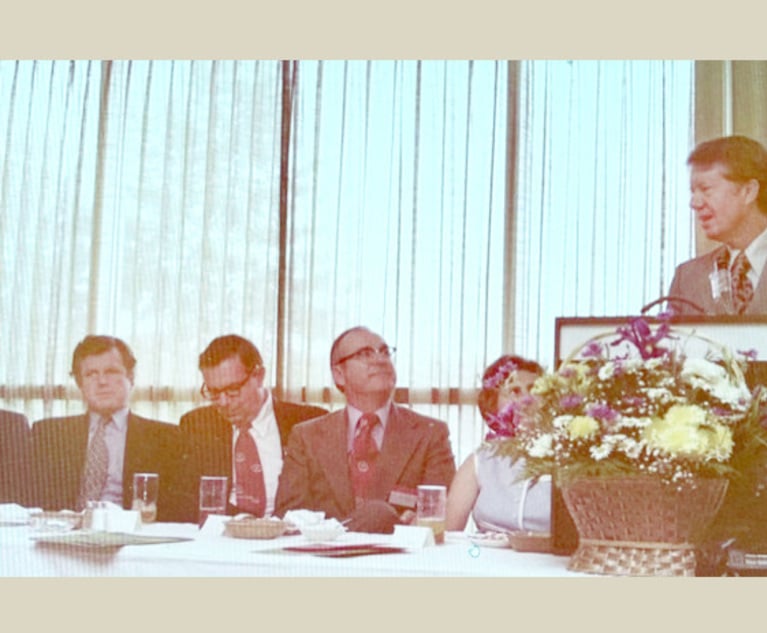Rise and Shine: Increasing Firm Visibility as a Young Partner
No matter your level within a firm, you are likely going to find yourself in a situation where your colleagues do not know who you are. Learn the necessities of the new environment and to be willing to adapt.
November 06, 2019 at 01:43 PM
6 minute read
 Washington, D.C.
Washington, D.C.
From the Editor: Natalie Bennett, a trial lawyer with Morgan Lewis and a 2019 NLJ D.C. Rising Star, writes about best practices for cultivating visibility as a young partner at a large law firm. And she takes the traditional mantra of "do good work and the rest will follow" a few steps further. To rise through the ranks and maximize visibility, young lawyers must be: adaptable, clutch team players and engage in pro bono service. For more in the latest column in our "On the Rise: Voices from Young Lawyers" series, read on. —Lisa Helem, editor-in-chief, The National Law Journal
To be visible in a law firm is to have a profile that sets you apart from your peers. Visibility as an associate or young partner means someone who is "front of mind." This is the person those with established client relationships first think of when it is time to pitch a new matter. The person is known as a "firm citizen" and a "superstar."
While visibility does not perfectly translate into making all your Big Law dreams come, it is certainly a prerequisite for law firm longevity. But it doesn't happen by accident. Here are some "best practices" for raising your profile at your firm:
Be a Team Player and Trusted Adviser.
You should be visible for the right reasons. Hopefully your goal is to be visible for your pleasant demeanor and willingness to assist your colleagues and clients rather than for your bad attitude. Life in a law firm can involve confrontations and inequity. However, the more you can stay focused on the ultimate team goals—like winning a case or closing a deal—the better positioned you will be in the long run to advance as someone who is easy to work with.
You will also be more visible by promoting others and helping identify opportunities for them than you will be if you only look out for yourself. So be willing to invest in your firm relationships. They will prove even more valuable later.
Be Willing to Reinvent Yourself.
No matter your level within a firm, you are likely going to find yourself in a situation where your colleagues do not know who you are. Learn the necessities of the new environment and to be willing to adapt.
 New Associates: You may have gone to law school with a singular focus in terms of practice area or industry. Whatever preconceived notions you had about what you thought you were supposed to do when you got to the firm, throw those out the window. The best opportunities are often the ones you never saw coming. Do not turn down assignments in an area in which you have no experience. Pursue the opportunity with an open mind and consider that you may not have enough experience to know where it may lead. When that random matter or random client comes along—the one that scares you because you feel ill-equipped—"Say yes." All too often those scary invitations are the opportunities that lead to finding your place within a firm.
New Associates: You may have gone to law school with a singular focus in terms of practice area or industry. Whatever preconceived notions you had about what you thought you were supposed to do when you got to the firm, throw those out the window. The best opportunities are often the ones you never saw coming. Do not turn down assignments in an area in which you have no experience. Pursue the opportunity with an open mind and consider that you may not have enough experience to know where it may lead. When that random matter or random client comes along—the one that scares you because you feel ill-equipped—"Say yes." All too often those scary invitations are the opportunities that lead to finding your place within a firm.
New Partners: Whatever laurels you earned as a standout associate may not translate to visibility at the partnership level. Your task now is to begin again. Until you have your own client following, the key is to find your niche. Be open to new kinds of matters or a different set of responsibilities. Find a role where you can redefine yourself as a valuable resource to the partnership. This may mean being more specialized than you were as an associate, gaining expertise you never had or supporting a team you have never worked with before. The bottom line: even as a partner you need to take risks in order to succeed.
Laterals: Gaining visibility as a lateral can be difficult. When you move firms, you lose years of social capital and institutional knowledge. To be visible as a lateral, dive in headfirst. Bet on yourself. You can impress your new colleagues with your work ethic, your specialized knowledge and your desire to serve your new firm's clients. But you need to be "all in." Go above and beyond to fit your practice into your new firm's platform. And ensure that your new colleagues feel rewarded for bringing you into the fold.
Spend Time on Non-Billable or Pro Bono Activities.
Do not be that person who is only known for billable work. Also become visible for making the firm and the world a better place. Join committees. Establish yourself as a leader internally and externally through professional organizations and the local bar.
Give back to the community. Not only will a diverse set of interests make you more appealing to clients, but these activities will also make you feel good about yourself. Firms today are not interested in their talent being one-dimensional. They are investing in people who, in addition to being essential to clients, will help raise the firm's external profile. Do not be afraid to dedicate time to the non-billable or pro bono causes you care about.
Lastly, pro bono opportunities not only provide representation to those in need. This work can also serve as a launching pad. Pro bono cases are a phenomenal way to collaborate with lawyers in other practice groups and to hone your substantive skills. A pro bono victory is an achievement that the entire firm can be proud of and makes your client's story visible to the world.
Natalie Bennett is an intellectual property trial and appellate attorney. She has been trying cases for the past 10 years and was thrilled to recently join the partnership at Morgan, Lewis & Bockius.
 Have you joined our group ALM Young Professionals Network on LinkedIn? We're having powerful conversations that tackle the challenges we all face early in our careers. Request to join here.
Have you joined our group ALM Young Professionals Network on LinkedIn? We're having powerful conversations that tackle the challenges we all face early in our careers. Request to join here.
This content has been archived. It is available through our partners, LexisNexis® and Bloomberg Law.
To view this content, please continue to their sites.
Not a Lexis Subscriber?
Subscribe Now
Not a Bloomberg Law Subscriber?
Subscribe Now
NOT FOR REPRINT
© 2025 ALM Global, LLC, All Rights Reserved. Request academic re-use from www.copyright.com. All other uses, submit a request to [email protected]. For more information visit Asset & Logo Licensing.
You Might Like
View All
Switching Positions: US Solicitors General and Climate Change Lawsuits
6 minute read
Jimmy Carter’s 1974 Law Day Speech: A Call for Lawyers to Do the Public Good
14 minute readTrending Stories
- 1'It's Not Going to Be Pretty': PayPal, Capital One Face Novel Class Actions Over 'Poaching' Commissions Owed Influencers
- 211th Circuit Rejects Trump's Emergency Request as DOJ Prepares to Release Special Counsel's Final Report
- 3Supreme Court Takes Up Challenge to ACA Task Force
- 4'Tragedy of Unspeakable Proportions:' Could Edison, DWP, Face Lawsuits Over LA Wildfires?
- 5Meta Pulls Plug on DEI Programs
Who Got The Work
Michael G. Bongiorno, Andrew Scott Dulberg and Elizabeth E. Driscoll from Wilmer Cutler Pickering Hale and Dorr have stepped in to represent Symbotic Inc., an A.I.-enabled technology platform that focuses on increasing supply chain efficiency, and other defendants in a pending shareholder derivative lawsuit. The case, filed Oct. 2 in Massachusetts District Court by the Brown Law Firm on behalf of Stephen Austen, accuses certain officers and directors of misleading investors in regard to Symbotic's potential for margin growth by failing to disclose that the company was not equipped to timely deploy its systems or manage expenses through project delays. The case, assigned to U.S. District Judge Nathaniel M. Gorton, is 1:24-cv-12522, Austen v. Cohen et al.
Who Got The Work
Edmund Polubinski and Marie Killmond of Davis Polk & Wardwell have entered appearances for data platform software development company MongoDB and other defendants in a pending shareholder derivative lawsuit. The action, filed Oct. 7 in New York Southern District Court by the Brown Law Firm, accuses the company's directors and/or officers of falsely expressing confidence in the company’s restructuring of its sales incentive plan and downplaying the severity of decreases in its upfront commitments. The case is 1:24-cv-07594, Roy v. Ittycheria et al.
Who Got The Work
Amy O. Bruchs and Kurt F. Ellison of Michael Best & Friedrich have entered appearances for Epic Systems Corp. in a pending employment discrimination lawsuit. The suit was filed Sept. 7 in Wisconsin Western District Court by Levine Eisberner LLC and Siri & Glimstad on behalf of a project manager who claims that he was wrongfully terminated after applying for a religious exemption to the defendant's COVID-19 vaccine mandate. The case, assigned to U.S. Magistrate Judge Anita Marie Boor, is 3:24-cv-00630, Secker, Nathan v. Epic Systems Corporation.
Who Got The Work
David X. Sullivan, Thomas J. Finn and Gregory A. Hall from McCarter & English have entered appearances for Sunrun Installation Services in a pending civil rights lawsuit. The complaint was filed Sept. 4 in Connecticut District Court by attorney Robert M. Berke on behalf of former employee George Edward Steins, who was arrested and charged with employing an unregistered home improvement salesperson. The complaint alleges that had Sunrun informed the Connecticut Department of Consumer Protection that the plaintiff's employment had ended in 2017 and that he no longer held Sunrun's home improvement contractor license, he would not have been hit with charges, which were dismissed in May 2024. The case, assigned to U.S. District Judge Jeffrey A. Meyer, is 3:24-cv-01423, Steins v. Sunrun, Inc. et al.
Who Got The Work
Greenberg Traurig shareholder Joshua L. Raskin has entered an appearance for boohoo.com UK Ltd. in a pending patent infringement lawsuit. The suit, filed Sept. 3 in Texas Eastern District Court by Rozier Hardt McDonough on behalf of Alto Dynamics, asserts five patents related to an online shopping platform. The case, assigned to U.S. District Judge Rodney Gilstrap, is 2:24-cv-00719, Alto Dynamics, LLC v. boohoo.com UK Limited.
Featured Firms
Law Offices of Gary Martin Hays & Associates, P.C.
(470) 294-1674
Law Offices of Mark E. Salomone
(857) 444-6468
Smith & Hassler
(713) 739-1250












